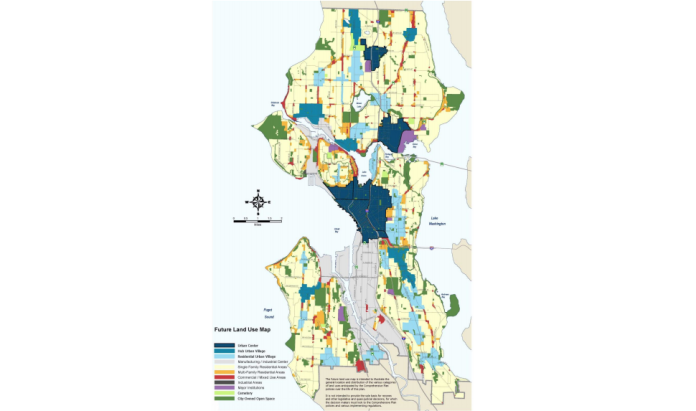At a formal signing event this afternoon (1.30pm), Mayor Ed Murray will sign Seattle’s new Comprehensive Plan (Seattle 2035) into law. The plan is an important asset to the city, carrying forward community values and objectives that policymakers and technicians alike rely upon to craft and enhance policy. The full document stands at more than 500 pages broken up into 14 Elements (e.g., Community Involvement, Land Use, Cultural and Historic Preservation, and Economic Development), dozens of Neighborhood Plans, and a series of Appendices.
The plan is built upon foundational background data like race, age, housing composition, income, growth trends, and more. In fact, population and employment growth are one of the most important inputs since increases in either category create a new needs like additional transportation, sewer, and development capacity to support them in addition to baseline needs. By 2035, Seattle is expected to grow by at least 120,000 residents, 70,000 housing units, and 115,000 jobs. The adopted plan recommits to the Urban Village Strategy focusing most new growth in urban centers and urban villages:
| Housing (% of 70,000 Units Citywide) | Employment (% of 115,000 Jobs Citywide) | |
|---|---|---|
| Urban Centers | ||
| Downtown | 17.1% | 30.4% |
| First Hill-Capitol Hill | 8.6% | 2.6% |
| University District | 5% | 4.4% |
| Northgate | 4.3% | 5.2% |
| South Lake Union | 10.7% | 13% |
| Uptown | 4.3% | 2.2% |
| Manufacturing/Industrial Centers | ||
| Duwamish | 0% | 5.2% |
| Ballard-Interbay | 0% | 2.6% |
| Total | 50% | 65.7% |
| Expected Housing Growth Rate* | Expected Job Growth Rate* | |
|---|---|---|
| Hub Urban Villages | ||
| With very good transit service** - Ballard - West Seattle Junction | 60% | 50% |
| With high displacement risk, regardless of the level of transit service - Bitter Lake Village - Mt. Baker (North Rainier) | 40% | 50% |
| Other hub urban villages - Fremont - Lake City | 40% | 50% |
| Residential Urban Villages | ||
| With very good transit service** - Crown Hill - Roosevelt | 50% | N/A |
| With high displacement risk, regardless of the level of transit service - 23rd & Union-Jackson - Columbia City - North Beacon Hill - Othello - Rainier Beach - South Park - Westwood-Highland Park | 30% | N/A |
| Other residential urban villages - Admiral - Aurora-Licton Springs - Eastlake - Green Lake - Greenwood-Phinney Ridge - Madison-Miller - Morgan Junction - Upper Queen Anne - Wallingford | 30% | N/A |
**Very good transit service means either a light rail station or a RapidRide bus service plus at least one other frequent bus route.
We’ve covered the update process nearly from its beginnings and well into the legislative process.
Seattle 2035: EIS Scoping and Comprehensive Plan Alternatives
PLUZ Committee Discusses Seattle 2035 Again, But Future Land Use Changes Remain A Question
Stakeholders from the public, hardworking planning and support staff, and City politicians from the Mayor to Council all deserve commendations for a rigorous public involvement process and commitment to building the best possible plan. But like any plan, it won’t be perfect: new issues will arise and invariably annual amendments will be necessary to keep pace with an evolving city. We already know what some of those are, including three Council-approved topics for 2017: updated industrial lands policies; possible Future Land Use Map (FLUM) changes in North Rainier, Eastlake, and Beacon Hill; and cultural and economic vitality policy changes in Chinatown/International District. Further policy changes could also come in the form of urban village expansions on the FLUM and complimentary text amendments to implement the Housing Affordability and Livability Agenda.
UPDATE (10/28/16): The Mayor has signed Seattle 2035 into law. The proof below.
@Seattle2035 is now signed by @MayorEdMurray! pic.twitter.com/y7gMc41Sxi
— Seattle Office of Planning & Community Development (@SeattleOPCD) October 28, 2016
Stephen is a professional urban planner in Puget Sound with a passion for sustainable, livable, and diverse cities. He is especially interested in how policies, regulations, and programs can promote positive outcomes for communities. With stints in great cities like Bellingham and Cork, Stephen currently lives in Seattle. He primarily covers land use and transportation issues and has been with The Urbanist since 2014.


